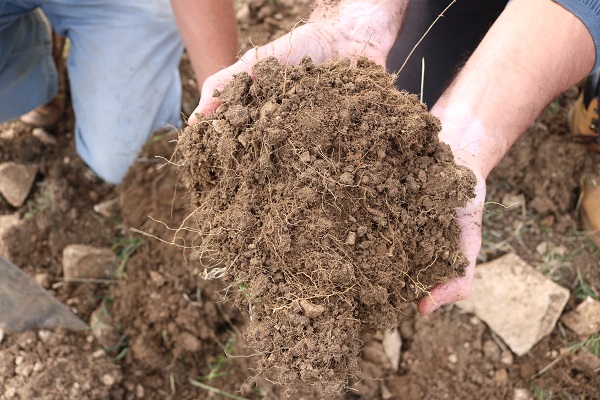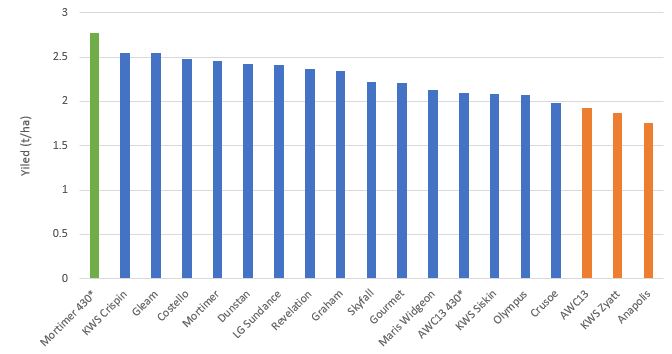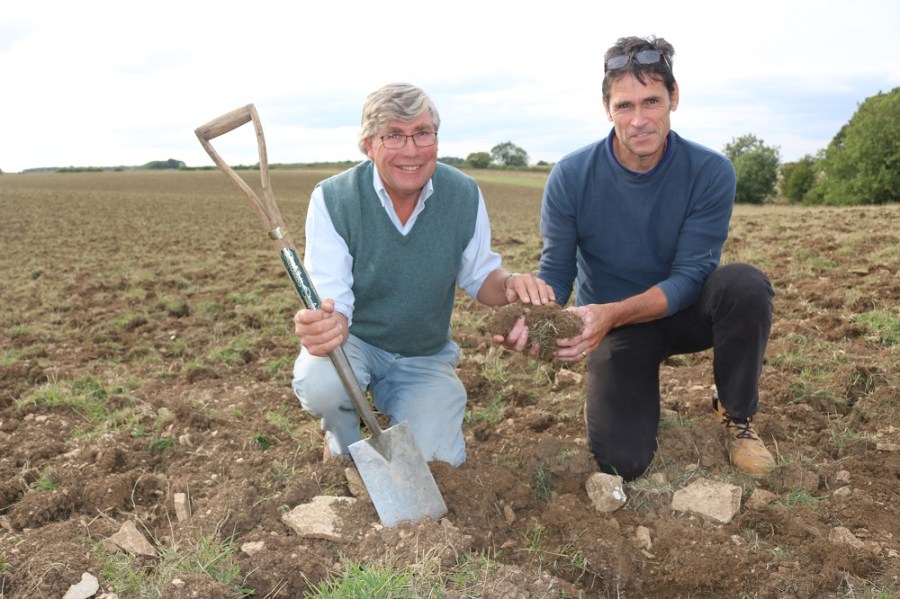An Innovative approach to on-farm trials is helping open up an untapped gene pool of wheat varieties for organic growers. CPM finds out.
What we’re doing is looking at the gene pool to find wheats that are better suited to an organic situation.
By Tom Allen-Stevens
You look across the field and wonder if it’ll ever make a seedbed. Large clods of turf sit in amongst the Cotswold brash – the remnants of a two-year fertility-building grass ley that will be followed by a crop of spelt wheat.
But looking at this soil through conventional eyes is probably missing the point. “We don’t have to produce a really fine seedbed because it won’t be receiving any residual herbicide,” points out Charles Hunter Smart, manager of Bradwell Grove Estate near Burford, Oxon.

The Cotswold brash soil is relatively low in productive capacity but has an organic matter of 6.5-7%.
“If it’s a bit lumpy and rough, I’m not worried. What I’m after is the organic matter, so I want to try to keep the turf in the top layer. It’s had a pass with a Gregoire-Besson rigid tine cultivator. We’ll want the weather to dry up and kill the turf, then see what we have before deciding what else to do to make the seedbed.”
Equally, the 10ha field, part of just over 900ha in arable crop rotations on the estate, won’t be receiving any glyphosate to knock out the green material that litters the pockmarked surface. This is an organic farm, and the five-year rotation includes two years of clover-rich herbal leys followed by three cereal crops, that may be winter wheat, winter or spring oats, spring barley or rye. As much as possible is grown for the expanding human-consumption market, but there are no hard and fast rotations on an organic farm.
The decision to convert to organic was made back in 2005, recalls Charles. “Grain prices were low and had been for some time, while oil prices were rising and pushing up the cost of fertiliser and other inputs. The soil is relatively low in productive capacity with only 10-15cm of topsoil over the limestone brash. We were spending as much on inputs as any arable farm and beginning to see herbicide resistance creep in.”
Charles drew up a number of scenarios, and it was the organic option that worked out best for the estate, owned by the Heyworth family, that includes 160ha of woodland, permanent pasture, and runs a 100-head pedigree Limousin and Angus cross beef suckler herd and includes the Cotswold Wildlife Park. Sheep, run as a stand-alone joint venture with another local organic farm business, also graze the grass leys and help build fertility in soils with organic matter now reaching 6.5-7%. Imported chicken manure, green waste compost and digestate are used to maintain nutrient status.
“We could have converted just 200ha, but I was beginning to question whether a conventional arable system was right for our soils. I was also inspired by An Agricultural Testament, a book by Albert Howard, that’s given me a greater understanding of the soil biota and how it all works together.”
One aspect that’s always been something of a limitation for organic arable farmers, however is variety choice, he says. “Conventional farmers get a lot of information through the AHDB Recommended List and a host of other sources to inform variety choice. On the organic side, there’s very little – the untreated RL trials give an indication and one or two seed merchants carry out organic trials of RL varieties. But no one’s been developing a gene pool ideally suited to organic farming.”
The Soil Association’s Jerry Alford confirms the lack of research. “In the conventional world, trials are everything, but in organic, even seed rate is trial and error. It’s understandable because you need the trial work in conventional farming to justify the inputs. Organic growers have very different requirements of their wheat varieties so it makes sense to look for those that are morphologically suited.”
Oddly, disease scores have little relevance, he says. “You don’t have the big lush canopies that encourage disease, so these scores can be misleading. But weed competition is important – Claire has always been a favourite variety due to its prostrate growth early on, ability to tiller and then it stands well.”
So a group of farmers have now teamed up, and with the help of Innovative Farmers, and some added support from Agrii, they’ve started their own set of organic variety trials. “Innovative Farmers is a network for farmers and growers who are running on-farm trials, on their own terms,” explains Jerry.
“It was launched in 2015, on the back of the notion that many of the best ideas in farming come from farmers themselves. But often, farmers are going it alone and what they learn stays on the farm. At the same time, researchers told us they wanted to work on projects that had real impact – for their work to be put into practice, rather than sitting in a weighty journal.”
Although Innovative Farmers is led by the Soil Association, it’s a partnership with LEAF, Innovation for Agriculture and Organic Research Centre (ORC). Any organic or conventional farmer can join the network to benefit from farmer-led research and suggest a field lab – on-farm trials designed to be practical and quick to set up. The farmers decide on the topic and the researcher helps design and analyse the trial. Currently there are over 30 field labs underway that can be on any issue that makes farm businesses more sustainable and resilient.
The idea for this trial came about through discussion with Agrii and the Soil Association, as well as others during other, unrelated trials Charles was carrying out on his farm. “I was doing some field-scale anaerobic digestate trials with ORC. It was a conversation with them that prompted the idea for a variety trials field lab.”
Sponsored by AHDB, the trials are located just at Bradwell Grove currently, run by Oxford Arable Trials and ORC, with input from Agrii’s David Neale and independent breeder Bill Angus. “What we’re doing is looking at the gene pool to find wheats that are better suited to an organic situation. It’s more than simply testing conventional varieties without inputs,” says Charles.
So alongside some familiar names in the candidates on trial are a few more unusual wheats.
Mortimer is a European variety, while AWC 13 is the new variety from Angus Wheat Consultants, originating from Hungary. Popular heritage variety Maris Widgeon, first registered in 1964, joins the line-up.
“We wanted to include some European lines. The market for organic on the continent is greater, with about 10% of land farmed compared with the UK’s 3%.”
The small-scale plot trials were sown in the 18ha field on 27 Oct with four replicates. “Longer term, the plan is to take three of the top performers and plant them in field-scale trials, to refine the agronomy. We also want more sites for the small-plot trials.”
The first year results are in and are currently being analysed by ORC. “There are one or two interesting findings,” notes Jerry.

Source: Innovative Farmers, Burford, 2018; Results adjusted to 15% moisture content; Green bar is statistically significant c/w orange bars, blue bars are not statistically significant; * Seed rate was 480seeds/m2, although Mortimer and AWC13 were also sown at 430 seeds/m2.
“Graham is supposed to do well disease-wise, but had the most septoria. Also, there doesn’t appear to be a correlation between yield and height, which is often seen as a trait to overcome weeds competition. Yield-wise, Mortimer came out on top, and was statistically better than AWC 13, Anapolis and KWS Zyatt.
“There are many varieties that don’t get onto the RL, but could suit organic growers. It’s not just organic that would benefit from these trials, though. There are many growers on less intensive arable systems who’d benefit from choosing a variety better suited to their production system. Weed suppression is also becoming more important in conventional systems as well.”
End-market suitability is also a key factor, and samples from the trials have gone to Nearby Shipton Mill for baking trials.
So what are the lessons learned so far from the first year of trials? “Varieties from Europe do look very promising and we need to look closer at what the options are,” says Jerry.
“We also need to consider the needs of livestock farmers in the UK – there’s a big demand for organic feed wheat. Much of this is met from imports but could be home-grown. We need to look especially towards high-protein varieties.”
The plan is for trials elsewhere in the UK next year, with those at Bradwell Grove continuing, and it’s important not to read too much into one year’s data, notes Jerry. “The crop of Revelation grown around the trial yielded 3.78t/ha, but was drilled two days earlier than the plots that averaged 2.37t/ha.”
Charles feels there’s huge potential for the trials to uncover wheats with untapped potential for the organic market. “The difficulty is that cereal breeding is currently drawn towards the conventional market. Rye is a classic example – we were getting good results from the crop for grain. But then the AD market opened up and breeders moved away from looking at grain characteristics towards its whole crop value, and that affects what varieties are available to organic growers. There’s a good market for rye breads all over Europe.”
Jerry feels they’ve just touched the tip of the iceberg in terms of the potential that could be sitting in varieties across Europe. “Breeders only select for what performs best in a conventional market, but I’m convinced the characteristics we’re looking for are available – we just haven’t focused on them. There’s so much genetic potential we’re simply not tapping into, but the tools are now there to discover these. So rather than cheating nature through gene-editing, let’s look at what nature and traditional breeding methods actually have to offer.”
“Contamination and sustainability” lead concerns over NBTs
The Soil Association is not the only influential stakeholder group that would like to see greater use made of traditionally bred wheats, rather than using NBTs such as GE. It’s the position also taken by IFOAM, the international umbrella organisation for organics, as well as some food and farming sustainability campaign groups.
NBTs are not compatible with organic farming and must not be used in organic breeding or organic production, says IFOAM, which supports the strict application of the GMO regulations on any release of NBTs into the environment. These ensure no cross contamination with nearby conventional crops or wild relatives, either through pollination or material carried off site, such as through volunteers or seed dispersal. Such regulation is seen as essential to maintain the rights of organic farmers to produce food free of GMOs.
The Sustainable Food Trust says it does not see a place for GM crops in agriculture at the present time, although it’s not ideologically opposed to them.
The trust recognises that GE appears to avoid some of the issues which caused it concern about GM crops. “The highly targeted approach to trait selection provided by GE may be less morally and environmentally problematic than the transgenic practices involved with conventional GM. Likewise, the relative speed and low cost with which gene editing can be carried out potentially brings a number of benefits,” says SFT CEO Patrick Holden.
“Nevertheless, new technologies of this sort which alter the fundamental nature of living cells raise multiple complex issues. In relation to newly evolving technologies such as CRISPR-Cas9, on balance we support the recent decision by the CJEU that GE crops should be considered equivalent to GM crops and subject to the same regulations. As a result, our feeling is that they should not be grown in the UK at the present time.”
A major concern is the potential for the technology to bring evolutionary change “on a massive scale” over a very short time period, notes Patrick. “One single mistake could have devastating consequences for humanity.”
GE also perpetuates “intensive, monoculture” food production methods SFT believes are largely responsible for the widespread degradation of cropland soils. “We believe there is still time to produce adequate food for the global population using food systems based on agro-ecological principles.”
Where the view of the UK consumer lies in this current debate is hard to gauge. Some dialogue and engagement research was carried out on behalf of the Royal Society last year, with findings published in Dec 2017. Of those asked to indicate whether the use of genetic technologies in plants for food to prevent crop damage is positive or negative for society, 77% said it was positive. The main concern was potential contamination of other crops, however. When asked whether GE plants should be cultivated in such a way as to prevent cross-contamination with non-GE plants, 72% agreed.
So has there been a shift in acceptance of NBTs? Author and environmental campaigner Mark Lynas, who works with the Cornell Alliance for Science, believes there’s no solid evidence of a change. “Greenpeace has downgraded its anti-GM campaign and there are one or two NGOs who have shifted their stance,” he says.
Himself a former activist against GM crops, Mark famously and publicly announced a volte face at the Oxford Farming Conference in 2013. He’s since campaigned against his former colleagues who he believes are preventing African and Asian farmers from accessing crop varieties that could address pressing pest and disease issues.
“What has shifted, however, is there’s more at stake,” notes Mark. “There are 815M undernourished people in the world, for instance, and that figure’s rising. GM crops have also had 20 years of safe and widespread use. But perhaps the most worrying aspect is that the anti-GM stance is part of a wider war on science that’s trying to undermine democracy itself.”
Future unclear for GE research
Researchers, campaigners and industry leaders have called for clarity on how research is to be conducted following the CJEU ruling.
Following the ruling, an open letter was sent to EC president Jean-Claude Juncker from a coalition of 15 NGOs, including IFOAM, Friends of the Earth, Slow Food, GM Freeze and GMWatch, calling for a halt to all unregulated releases of GE crops to the environment. The letter also asks for border controls to be applied to GE material, including imports, and for plant breeders and seed companies to be obliged to exercise “full transparency” on techniques used to breed, select and multiply varieties.
It’s not a view shared by all environmental groups, however, many of whom did not sign the letter. The Green Alliance, for example, claims it has a growing network of influential leaders in business, NGOs and politics to stimulate new thinking and dialogue on environmental policy, and increase political action and support for environmental solutions in the UK. While it claims successes in areas such as climate change and waste reduction, it steers clear of new breeding technologies.
On the research side, concern revolves around two aspects – the potential for misuse of NBTs, such as CRISPR, and what happens once GE plants leave the confines of labs and greenhouses. With the knowledge and understanding of CRISPR now widespread, the cost of the technique has plummeted – you can buy a ‘BioHack’ CRISPR kit through the internet for just $159 (£120) – although to reconstruct a plant from an engineered embryo is still costly and specialised work.
All GE research carried out in authorised EU labs and greenhouses follow GMO regulations, while in the UK, there’s one gene-edited field trial currently underway, of camelina at Rothamsted Research. This is also carried out under GMO regulations, despite an authorisation from the Advisory Committee on Releases to the Environment (ACRE), made before the CJEU ruling, concluding the plants are genetically indistinguishable from those that could be bred naturally, indicating GMO restrictions were not necessary.
But the expense involved in developing GE crops under GMO regulations would preclude investment by all but the very largest biotech companies. This is the view of 33 UK research institutes, breeders, biotech companies and farming organisations. Last month, a letter they signed was delivered to Defra secretary of state Michael Gove, calling for a round-table discussion with all stakeholders, including Defra, to decide the best way forward on GE crops.




